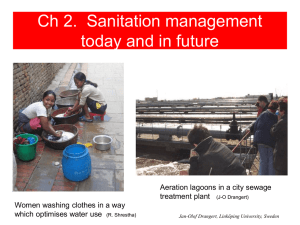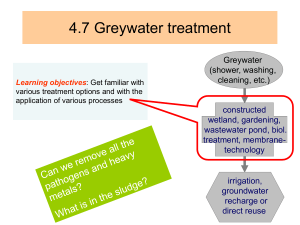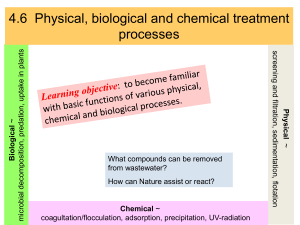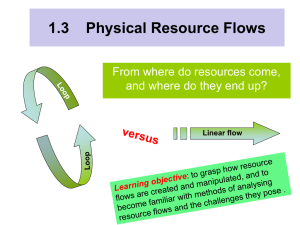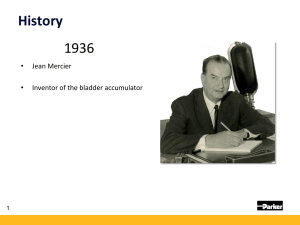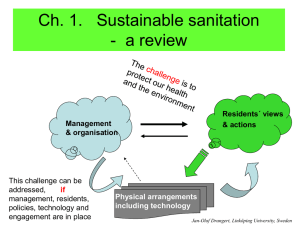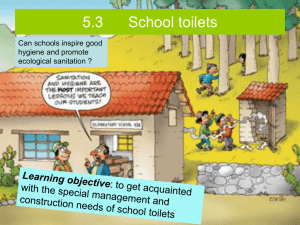ppt - Sustainable Sanitation
advertisement
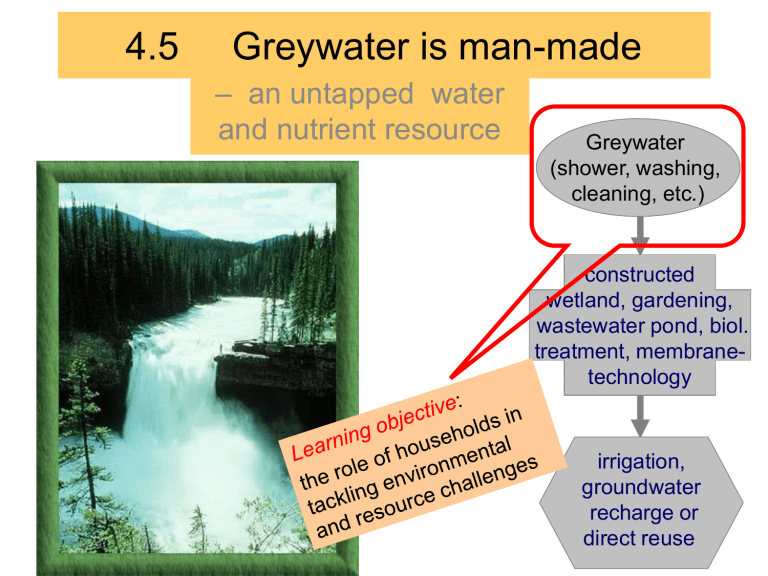
4.5 Greywater is man-made – an untapped water and nutrient resource Greywater (shower, washing, cleaning, etc.) constructed wetland, gardening, wastewater pond, biol. treatment, membranetechnology irrigation, groundwater recharge or direct reuse Challenges and possibilities Greywater represents environmental challenges: - Unpleasant odours Health hazard (pathogens and toxic compounds) Soil erosion Pollution of surface water and groundwater Mosquito breeding Benefits of using treated greywater and sludge: + Reduces water shortage + Reduces environmental degradation, eutrophication and health hazards + Reclaims otherwise wasted nutrients + Alleviates food shortages and poverty + Protects the quality of groundwater Courtesy of Nicola Rodda University of KwaZulu Natal, Durban Urban horizontal water and nutrient flows Urban waste Surface & ground water Rain Storm water Urban Compost Faeces Compost & hygienization Lower quality Treatment Drinking water Sludge Solid waste Activities Horticulture Agriculture Urine Hygienization & concentration Forestry Grey water Hygienization membrane biological Aquaculture Black water Wetland aquacult Industry Waste water Sludge fractionation biological treatment Household Jan-Olof Drangert, Linköping University, Sweden Urban unintended vertical flows of contamination Landfill Sludge bed Irrigation Pit latrines Septic tank Petrol station Sewers Soil layer with organic material, clays and charged particles Groundwater (saturated aquifer) Jan-Olof Drangert, Linköping University, Sweden The effects of urbanisation on groundwater utilisation, quantity and quality Water volumes (supply & disposal) Imported water time Shallow wells Periurban wells Deeper wells Settlement size Effect on quantity: None Falling grw-level Over extraction Excess infiltration Effect on quality: None Growing pollution Excessive pollution Courtesy of G. Jacks, Royal Institute of Technology, Stockholm All groundwater under cities is polluted Source: Powell et al., 2003 Wastewater = clean water + what has been added Component Content in different fractions Faeces Impact (potential) Means of control - water scarcity - heat loss - investment - water logging - behaviour - fee structure - water saving equipment - ‘no’ faeces in water - hygienic handling - aerobic treatment - minimize exposure Physical, aerobic, anaerobic treatment Urine Greywater 4-10 (WC) 0 (no flush) 20-40 (WC) 0 (no flush) 80-200 Pathogens (bacteria, viruses, helminths) high very low low - infections Organic matter BOD kg/p/year 5.5 2 Excreta 7.5 10 Phosphorus kg/person/year 0.2 -deplete oxygen -bacteria growth -eutrophication Nitrogen kg/person/year 0.5 Water lit/person/day flush included 0.4 4 Mean value 5.0 0.05-0.3 0.5 urine separation, precipitation, etc urine separation, aerobic/anaerobic Heavy metals present negligible present -eutrophication -consume oxygen -toxic to humans Organic toxic compounds negligible negligible present -toxic to humans Aerobic treatment Pharmaceutical residue/hormone present negligible negligible -toxic for aquatic Degrade in top soil use other products Courtesy of Peter Ridderstolpe, WRS, Uppsala, Sweden What do we put into the water? What is in soap, detergents, shampoos, solvents, disinfectants, paints, medicines, pharmaceuticals, etc ? Soap contains alkali salts with long-chained fatty acids: Hard soap usually contains sodium (Na) Liquid soap usually contains potassium hydroxide (K) Detergents can contain (check list of contents on package) – Phosphorous in water and on soil – which can be replaced by potassium or – Salts: sodium or – Bleaches: chlorine and peroxide – Fluorescent whitening agents – Non-degradable substances: zeolites or and fillers or Courtesy of H. Jönsson, Swedish University of Agricultural Sciences, Sweden Toxic organic compounds O O NH P NH Ifosfamide 0% biodegradable HO HO Phthalates O O O NH OH P NH Cl Cl Cl Cl Glufosfamide (ß-D- Glc -IPM) 70% biodegradable, improved up-take in the gut Source: Kümmerer, 2007 Metals in wastewater & excreta Element Copper 1. 2. 3. 4. 5. 6. Daily intake (mgr) Output in faeces (mgr/kg P) Found in sludge (mgr/kg P) Quotient Output in urine (mgr/kg P) Quotient 3 2 Cu 1,400 1,000 14,000 14 Chromium Cr 300 214 1,300 6 Nickel Ni 120 88 720 8.3 16 78 Zinc Zn 11,000 7,200 25,000 3.5 424 69 Lithium Li 17 12 Mercury Hg 5 40 11 Lead Pb 23 16 1,500 94 Cadmium Cd 14 10 44 4 3,5 68 3 5 0.65 206 2,000 0.64 63 16 0.32 94 137 Courtesy of G. Lindgren, Sweden Can we cope with the chemical society ? What we know: 1. Metals and man-made organic material do NOT disappear, but 30 000 chemical compounds ”treatment” 2. ... they may adsorb to particles 3. Organics decompose into ... 4. inorganic substances and gas, but do NOT disappear 20 monitored 29 980 unknowns Jan-Olof Drangert, Linköping University, Sweden A: Source control comes first s l u d g e Aerobic process: - Trickling filter - Soil/sand filter - Mulch filter - Vertical flow constructed wetland - Ponds– facultative maturation etc. Anaerobic process: - Anaerobic baffled reactor - Anaerobic pond Usages: Minimise water use, reduce contamination by chemicals, oil, particles, fats, excreta Quality of material & workmanship is a FIRST priority! Courtesy of Peter Ridderstolpe, WRS, Uppsala, Sweden Storage of urine/faeces, septic tank, grease filter, screen, etc. Service water Resorption Surface irrigation Sub-soil irrigation Infiltration To surface water Households can contribute – NOW! Use as little water as possible by mimicking the use of water in buckets (do not wash under running tap, take quick showers, mend leaking taps, put full loads in washing machines, ...... ) Do NOT add solid matter to water (put food scraps from plates and utensils in the waste bin, do not flush tooth picks etc. down the toilet, do not put cigarette butts in urinal, ...... ) Do NOT add chemicals and oils to the water while using it (put fat from frying pan in the solid waste bin, use biodegradable soap and detergent, do not flush paint, medicines or other chemicals down the toilet, .... ) Buy and use environmentally friendly products for your home Then you can use greywater in your garden, and you avoid blockages Jan-Olof Drangert, Linköping university, Sweden Households can invest: install proper devices in your kitchen and bathroom When you build or retrofit your home: - Buy water- and energy-saving devices e.g. water-efficient shower heads, taps, washing machines and low-flush toilets - Install a dry or low-flush urine-diverting toilet to recover nutrients and to save water - Avoid leaking taps and keep a record of the amount of water used every now and then to monitor your usage Example: A new suburb in Stockholm, Sweden with proper saving devices achieved (www.stockholmwater.se): - a 40 % reduction in water use - a 25% reduction in hot water use (= energy saving) - a 50% reduction in eutrophying substances to the lake Jan-Olof Drangert, Linköping university, Sweden ”Benign by design” - manufacturers need not make products with problematic content Classical view on functionality of chemical products: + stable (persistent) New view: + complete and fast degradation + no risk of harmful effects + effective + effective + efficient + efficient + affordable + affordable Source: Kümmerer, 2007 TPS non-biodegradable for washing powder LAS readily biodegradable replacement of TPS Supervision: nonylphenol in car care products mg/kg dry matter 400 350 300 250 Nonylphenol in digested sludge in Stockholm, mg/kg d.m. Nonylphenol in digested sludge Henriksdal 200 150 Car wash Bromma Applyin g law on product choice 100 50 0 1990 1991 1992 1993 1994 1995 1996 1997 1998 1999 2000 2001 2002 2003 2004 2005 2006 Courtesy of Arne Jamtrot, Stockholm City Media attention: Triclosan in toothpaste % of toothpastes containing triclosan % in 2006: % in 2010: 000 00 00 0 00 0 0 Courtesy of Arne Jamtrot, Stockholm City Subsidies: Hg in sewers at dental clinics 3.5 Did the campaign make a difference? 3 280 kg mercury was removed 1998 and 2004 mg Hg/kg DS 2.5 2 1.5 Section of sewer with Hg nuggets 1 0.5 0 1997 1998 1999 2000 2001 2002 2003 2004 2005 Courtesy of Arne Jamtrot, Stockholm City
